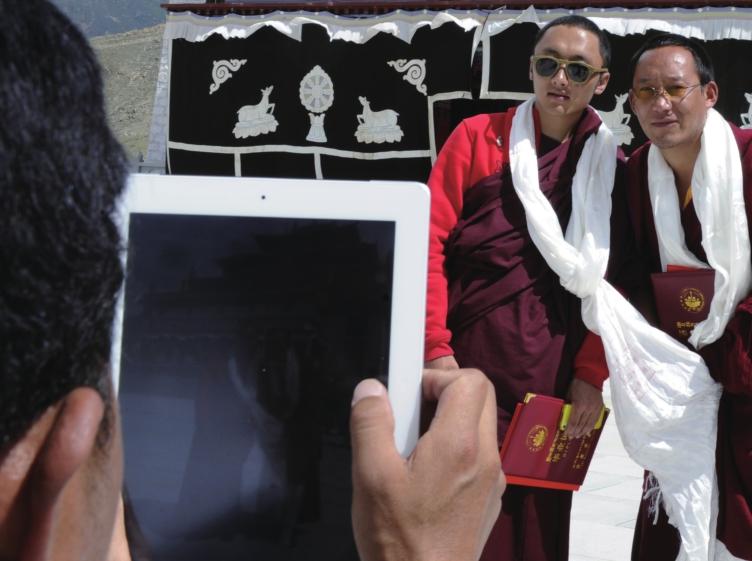RELIGIOUS TRANSFORMATION
2019-04-15ByDejiDroma
By Deji Droma

Tremendous changes have taken place in Tibet in the 60 years since the launch of democratic reform. Abolishing the theocracy changed the previous social structure and conformed to the trend of world progress. The move also satisfied the demand of Tibets social development, while guaranteeing the political right of people in Tibet to equally participate in state affairs and their autonomous right of managing local and ethnic affairs. This laid a solid social foundation for the modernization and prosperity of Tibet.
Meanwhile, the government has carried out an effective religious policy, bringing substantial changes to religion in Tibet through an evolutionary process.
Since the Peoples Republic of China was founded in 1949, Tibet has experienced three important historic stages: peaceful liberation, democratic reform and the establishment of the autonomous region. Before peaceful liberation, a theocracy existed in Tibet. In the early period thereafter, the government prudently held a policy of respecting the belief of religious people in Tibet, protecting Tibetan Buddhist temples and maintaining the existing religious system.
During the period of democratic reform, the government put forward a basic principle of political unity, freedom of religious belief and separation of religion from the state. Religious privileges, exploitation and oppression were abolished with the overthrow of feudal serfdom. Meanwhile, the legitimate rights and interests of the patriotic and lawabiding temples, as well as normal religious activities, were protected.
The Central Government sought to make Tibetan Buddhism conform better to Tibets social development and progress through democratic reform, which ushered in a new era in the history of religion in Tibet. Abolishing theocracy and establishing a democratic administrative system of temples have fundamentally changed the social attributes, status and functions of religion in Tibet, ensuring that the people enjoy the freedom of religious belief endowed by the Constitution to all Chinese citizens.
Benefits to temples
Respecting the freedom of religious belief is a long-term basic policy of the Communist Party of China (CPC) and the Chinese Government.
In May 1980, the Tibet Autonomous Regional Committee of the CPC issued a document detailing specific measures on continuing to implement the policy. Providing appropriate venues for religious activities, put forward by the CPC Central Committee in 1982, has, in particular, been an important goal in Tibet. Starting in 1980, the Central Government allocated special funds for repairing temples. Three major monasteries in Lhasa, namely, the Drepung Monastery, the Sera Monastery and the Tashilhunpo Monastery, as well as other influential monasteries and temples such as the Jokhang Monastery, the Ramoche Temple, the Samye Monastery, the Mindroling Monastery and the Qamdo Temple have all been repaired with funds from the central and local governments. The Central Government has also appropriated a large amount of gold, silver and other precious materials to repair the Potala Palace. During the 13th Five-Year Plan (2016-20) period, special funds for protecting cultural relics in Tibet will double from the previous five years to at least 2 billion yuan ($297 million).
The government has also been ef-fectively protecting the culture of Tibetan Buddhism as an important part of traditional Chinese culture. The collection, publishing and research of Tibetan Buddhist classics have been enhanced, and a large number of religious books in the Tibetan language have been rescued and protected. In the next 10 years, China will earmark special funds totaling 300 million yuan ($44 million) for the protection and utilization of ancient documents in the Potala Palace, the largest program of its kind in the history of the palace.
Tibetan Buddhist temples are both venues for religious activities and basic social units. Based on this understanding, as well as their status as citizens, monks and nuns enjoy the same rights to public services as other social units and members. The government has enhanced public services to temples by improving infrastructure and accommodations. In addition, all registered monks and nuns living in temples are covered by the social security system, enjoying medical insurance, endowment insurance, subsistence allowances, personal accident insurance and free physical examinations every year.
New features
The law-based administration of religious affairs and other social affairs is one of the important marks of modern society. As new laws and regulations are formulated tak- ing into account new circumstances and new problems, the management of Tibetan Buddhist affairs has improved.

For instance, since the measure on the reincarnation of living Buddhas went into effect on September 1, 2007, more than 60 new living Buddhas in Tibet Autonomous Region have been recognized accordingly. While protecting the freedom of religious belief, this measure respects the history and customs of reincarnation, as well as preserving the characteristics and religious rituals of Tibetan Buddhism. As a result, the reincarnation of living Buddhas is better regulated, promoting the sound development of Tibetan Buddhism.
In addition, regarding temple management as a key to ensuring the development and stability of Tibet, the government has established a long-term mechanism on temple management in accordance with law.
Religion must suit local society. It must change as social conditions change in order to adapt to different social environments. In the past 60 years, the government has been guiding Tibetan Buddhism to adapt.
At a conference on religions held in April 2016, President Xi Jinping said one key mission in helping religions adapt to the socialist society is localization.
This mission calls for efforts from both the government and religious circles. Doctrines and rules of Tibetan Buddhism are interpreted in a way that is conducive to modern Chinas progress and in line with excellent traditional culture. Talent training for Tibetan Buddhism has been stressed. The Tibet Buddhist Theological Institute and 10 branch institutes have been established, creating a new approach to training religious professionals in modern educational institutions.
The government attaches importance to the education and guidance of monks and nuns, strengthening their awareness of loving their country and religion and abiding by the law. It also encourages representatives of the religious circle to elaborate to the public the relationship between patriotism and religion, and between obeying the law and obeying monastic rules, with the aim of maintaining harmony and stability in the religious field.
Practices in the past 60 years prove that great changes have taken place in religious affairs in Tibet. With these achievements, Tibetan Buddhism has entered the best period for development.
